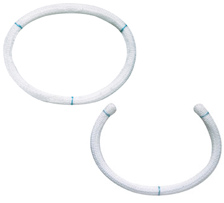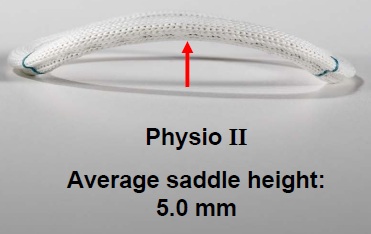|
Current and Future Devices
As mentioned previously, the majority of currently marketed annuloplasty rings are for mitral or tricuspid valve repair, due to the repairability and large volume of repairs on those valves using rings. In addition, most rings are are niche products, attempting to be the superior device for repairing a smaller set of diseases, rather than attempting to be applicable to a wide variety of valvular dysfunctions. A number of common features have emerged from the devices marketed by the two primary annuloplasty ring manufacturers, Edwards LifeSciences and Medtronic, which will be discussed below.
Flexibility vs. Rigidity
The flexibility of a ring generally determines which diseases it can treat. Medtronic offers three separate rings, each with its own level of rigidity. The Profile 3D ring is fully rigid and is marketed for treatment of ischemic mitral regurgitation, which requires more support that more flexible rings provide, while the Duran AnCore ring is flexible for treatment of diseases that don't need as much support, reducing stress on the sutures and allowing the annulus to flex during the cardiac cycle. The company's CG Future ring is semi-rigid and stands in the middle of their other two products.
Full Ring vs. Partial Ring
Both companies offer versions of their rings that do not form a complete loop. The purpose of this is to allow the anterior portion of the valve to retain its natural function in case the entire annulus does not need to be remodeled. This feature is especially important in older models that do not accommodate native annulus geometries as well as newer ones. Models with this option include Medtronic's Duran AnCore, CG Future, and Profile 3D rings and Edwards' Cosgrove-Edwards and Edwards MC3 rings.
Saddle Shape
Studies have shown that a saddle shape in the annuloplasty ring reduces stress on the leaflets and increases valve durability. Medtronic's Profile 3D ring and Edwards' Physio rings both contain this feature. As the newest valve on the market, Edwards' Physio II ring takes this concept a bit further with a double saddle design, which confers a mechanical advantage to the leaflets by adding curvature and coaptation surface (surface area where the leaflets physically touch one another as they close). Furthermore, this shape has been shown through computer modelling (as in the model below) to restore the natural shape of the annular orifice to reduce stress on the sutures and consequent risk of dehiscence.

Applicability
Rather than create a single ring to treat all repairable valvular diseases, the two companies have instead opted to create entire portfolios of rings that can be used to treat each disease. While this approach works generally, a more adaptive ring would have an advantage in manufacturing, as a single model could be produced, rather than several different ones.
Future Ring Designs
While rings are currently very durable and can treat a wide array of valvular problems, there is always room to improve on applicability, durability, biocompatibility, and cost. Furthermore, with the recent widespread use of computer modeling, optimization work to determine the best geometries and stiffnesses will become important to continue improving these devices.
|


